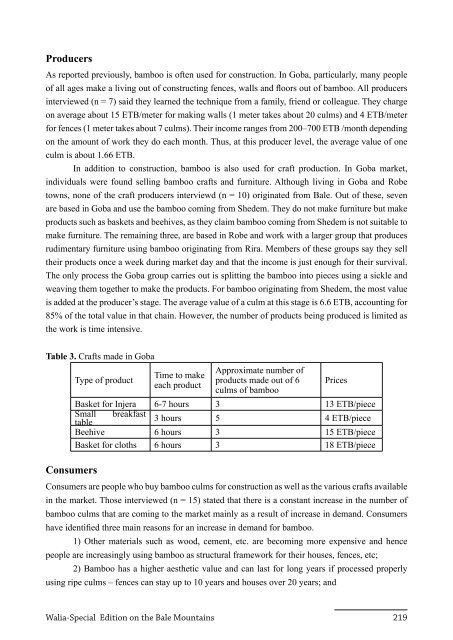Walia Special Edition on the Bale Mountains (2011) - Zoologische ...
Walia Special Edition on the Bale Mountains (2011) - Zoologische ...
Walia Special Edition on the Bale Mountains (2011) - Zoologische ...
Create successful ePaper yourself
Turn your PDF publications into a flip-book with our unique Google optimized e-Paper software.
Producers<br />
As reported previously, bamboo is often used for c<strong>on</strong>structi<strong>on</strong>. In Goba, particularly, many people<br />
of all ages make a living out of c<strong>on</strong>structing fences, walls and floors out of bamboo. All producers<br />
interviewed (n = 7) said <strong>the</strong>y learned <strong>the</strong> technique from a family, friend or colleague. They charge<br />
<strong>on</strong> average about 15 ETB/meter for making walls (1 meter takes about 20 culms) and 4 ETB/meter<br />
for fences (1 meter takes about 7 culms). Their income ranges from 200–700 ETB /m<strong>on</strong>th depending<br />
<strong>on</strong> <strong>the</strong> amount of work <strong>the</strong>y do each m<strong>on</strong>th. Thus, at this producer level, <strong>the</strong> average value of <strong>on</strong>e<br />
culm is about 1.66 ETB.<br />
In additi<strong>on</strong> to c<strong>on</strong>structi<strong>on</strong>, bamboo is also used for craft producti<strong>on</strong>. In Goba market,<br />
individuals were found selling bamboo crafts and furniture. Although living in Goba and Robe<br />
towns, n<strong>on</strong>e of <strong>the</strong> craft producers interviewd (n = 10) originated from <strong>Bale</strong>. Out of <strong>the</strong>se, seven<br />
are based in Goba and use <strong>the</strong> bamboo coming from Shedem. They do not make furniture but make<br />
products such as baskets and beehives, as <strong>the</strong>y claim bamboo coming from Shedem is not suitable to<br />
make furniture. The remaining three, are based in Robe and work with a larger group that produces<br />
rudimentary furniture using bamboo originating from Rira. Members of <strong>the</strong>se groups say <strong>the</strong>y sell<br />
<strong>the</strong>ir products <strong>on</strong>ce a week during market day and that <strong>the</strong> income is just enough for <strong>the</strong>ir survival.<br />
The <strong>on</strong>ly process <strong>the</strong> Goba group carries out is splitting <strong>the</strong> bamboo into pieces using a sickle and<br />
weaving <strong>the</strong>m toge<strong>the</strong>r to make <strong>the</strong> products. For bamboo originating from Shedem, <strong>the</strong> most value<br />
is added at <strong>the</strong> producer’s stage. The average value of a culm at this stage is 6.6 ETB, accounting for<br />
85% of <strong>the</strong> total value in that chain. However, <strong>the</strong> number of products being produced is limited as<br />
<strong>the</strong> work is time intensive.<br />
Table 3. Crafts made in Goba<br />
C<strong>on</strong>sumers<br />
Type of product<br />
Time to make<br />
each product<br />
Approximate number of<br />
products made out of 6<br />
culms of bamboo<br />
Prices<br />
Basket for Injera 6-7 hours 3 13 ETB/piece<br />
Small<br />
table<br />
breakfast<br />
3 hours 5 4 ETB/piece<br />
Beehive 6 hours 3 15 ETB/piece<br />
Basket for cloths 6 hours 3 18 ETB/piece<br />
C<strong>on</strong>sumers are people who buy bamboo culms for c<strong>on</strong>structi<strong>on</strong> as well as <strong>the</strong> various crafts available<br />
in <strong>the</strong> market. Those interviewed (n = 15) stated that <strong>the</strong>re is a c<strong>on</strong>stant increase in <strong>the</strong> number of<br />
bamboo culms that are coming to <strong>the</strong> market mainly as a result of increase in demand. C<strong>on</strong>sumers<br />
have identified three main reas<strong>on</strong>s for an increase in demand for bamboo.<br />
1) O<strong>the</strong>r materials such as wood, cement, etc. are becoming more expensive and hence<br />
people are increasingly using bamboo as structural framework for <strong>the</strong>ir houses, fences, etc;<br />
2) Bamboo has a higher aes<strong>the</strong>tic value and can last for l<strong>on</strong>g years if processed properly<br />
using ripe culms – fences can stay up to 10 years and houses over 20 years; and<br />
<str<strong>on</strong>g>Walia</str<strong>on</strong>g>-<str<strong>on</strong>g>Special</str<strong>on</strong>g> <str<strong>on</strong>g>Editi<strong>on</strong></str<strong>on</strong>g> <strong>on</strong> <strong>the</strong> <strong>Bale</strong> <strong>Mountains</strong> 219
















